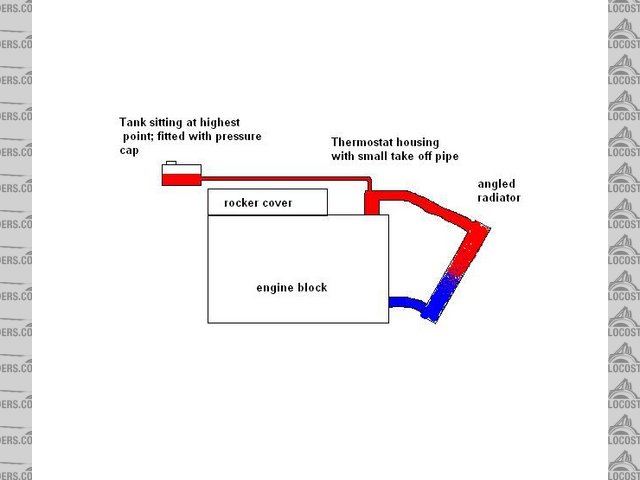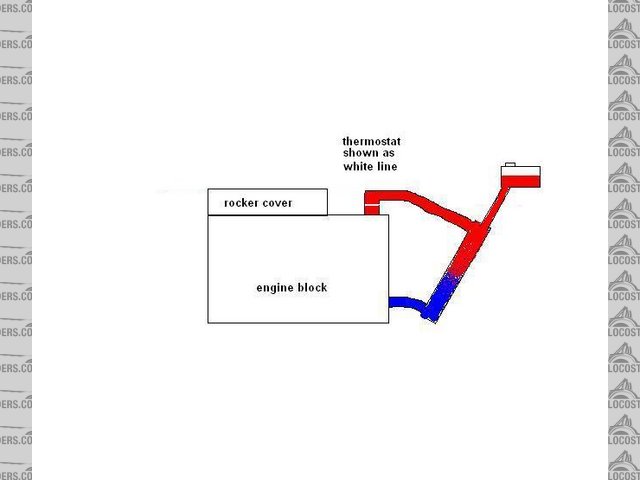

Rescued attachment Water Pump diagram4.jpg

still haven't figured out how to use an expansion tank. In a haynes manual it shows there are two pipes to an expansion tank.
As the top of my tilted radiator may be below thermostat housing, I may need to plumb in a small tank that sits in the highest position to avoid air
locks.
I have spare thermostat housing with an outlet; this would go to the expansion tank.
CBS sell sealed radiator cap that I would need to fit, the expsnion tank now will have the pressurised cap.
So is my thinking correct? If so, then I need to source an expansion tank with a pressuried can and one outlet - anyone know which cars I need to
look at?
thanks.
I used an expansion tank from an Astra (D reg) it's got 2 connections, but you could easily blank one off witha short length of hose, a bolt and
some jubilee clips.
Cheers
Nick
Clio Mk3/4 is nice as it mounts to a flat panel with ease.
I'll try and post a pic later.
okey dokey; sounds like my plan is sound and blocking off excess outlets is the way to go.
now need to find the right sized/shaped tank......
Are you sure you need an expansion tank? I am hoping to get by with just a header tank and bleed hose as in this diagram.


Rescued attachment Water Pump diagram4.jpg
RazMan, maybe I am comnfusing header and expansion tank!!
In my mind I need a small thank that sits at the highest position in the water system. The system needs to be pressurised hence the cap must be a
pressure type. This is a side view of what I mean - proably the same as yourswithout the heater stuff.


header tank
RM; in your case, the header tank has to have a pressure relief valve in the cap otherwise isn't there are danger something will explode?? If the
tank is vented, then water is not pressuried so will boil at a lower temperature?
Is your pressure is regulated by the radiator cap; in mine case it won't be.
[Edited on 21/12/05 by 02GF74]
I'm with Razman on this one!
Most pressurised header tanks have at least 2 connections - a larger one that connects into the main plumbing, as in his diagram, and a smaller one
that goes to the highest point in the engine's water system - the extra connection on your thermostat housing. The smaller one is there mostly
to collect any air that's bubbling round the engine. Any extra small connections are for systems that need to catch any airlocks in strange
places.
rgds,
David
quote:
Originally posted by David Jenkins
I'm with Razman on this one!
Most pressurised header tanks have at least 2 connections - a larger one that connects into the main plumbing, as in his diagram, and a smaller one that goes to the highest point in the engine's water system - the extra connection on your thermostat housing. The smaller one is there mostly to collect any air that's bubbling round the engine. Any extra small connections are for systems that need to catch any airlocks in strange places.
rgds,
David
 (there is some stuff going to the manifold
but not had time to trace it round)
(there is some stuff going to the manifold
but not had time to trace it round)
Don't worry - I went through stuff like this a while ago! If you look at this thread you'll see what I mean...
LINKY
Have a look down the page to Dave Ashurst's diagram - that just about covers it all.
BTW: you don't mention the heater plumbing anywhere - either you have a heater, or you must have a loop of pipe between the 2 places where the
heater gets connected to the block. This is an ideal place to break into the circuit and fit a T-piece for the expansion tank.
cheers,
David
[Edited on 21/12/05 by David Jenkins]
I think we are probably talking about the same thing although I am a little foggy about the terminology too.
Your diagram is practically identical to mine without the heater. If you put a 'tank' on the feed side of the pump and connect a bleed hose
between the tank and rad top (or thermostat housing in your case), the whole system should be self bleeding.
*edit* Yes, my cap is a pressure cap rated at 15psi iirc. I was under the impression that a pressurised system was the best way to go - but I havent
got the foggiest idea really so I just listen to advice and go with the options that make the most sense. It's a steep learning curve when
building a car isn't it? 
[Edited on 21-12-05 by RazMan]
I have two pipes on my header tank, one from the thermostat on the top of the engine to the top of the tank. This is for air to escape. One from the
water pump to the bottom of the tank, this is to put water into the system to make up for expelled air (or water leaks!)
With one pipe, you are hoping for air to go in one direction and water in the other.
quote:
Originally posted by smart51
I have two pipes on my header tank, one from the thermostat on the top of the engine to the top of the tank. This is for air to escape. One from the water pump to the bottom of the tank, this is to put water into the system to make up for expelled air (or water leaks!)
With one pipe, you are hoping for air to go in one direction and water in the other.

When the thermostat is closed, the water will circulate round the heater circuit - it's never shut off, unlike the main radiator circuit - that's why I said that you either need a heater, or a piece of hose to replace it.
Even with a heater in circuit you still need the flow though a closed thermostat - what if the heater valve is switched off?There is always some flow through a closed thermostat but as 02GF74 says you can always drill an extra hole in it to increase it if needed.
what is difference between my first picture and this one?


header tank/rad
you can look at this as the tank being part of the conventional radiator albeit the hose to it is much smaller.
Note in my pic I am using the thermostat take of as an extension of the main cooling system so it remains full rather than an air bleed.
.... I realise this piccy ^^^ there is potential for air locks, but let's ignore those for now.
[Edited on 21/12/05 by 02GF74]
Got a tee piece from a ford in a breakers yard that fitted nicely. Can't remember which Ford though
Have another look at Dave Ashcroft's drawing on the other thread - this matches just about every car out there that has a pressurised header
tank. Any attempt to cut corners will either not work, not work very well, and/or simply give you no end of problems.
Why not just do it properly?
David
[Edited on 21/12/05 by David Jenkins]
quote:
Originally posted by David Jenkins
Have another look at Dave Ashcroft's drawing on the other thread - this matches just about every car out there that has a pressurised header tank. Any attempt to cut corners will either not work, not work very well, and/or simply give you no end of problems.
Why not just do it properly?
David
[Edited on 21/12/05 by David Jenkins]


if you try to fill a closed loop system with only one hose connection though a small bore hose you will be there all day cause the air has no where
to go but up the same hole that you are trying to pour water down
try filling an empy bottle ysung a funnel that is jammed in the opening and you'll se what i mean
quote:
Originally posted by timf
if you try to fill a closed loop system with only one hose connection though a small bore hose you will be there all day cause the air has no where to go but up the same hole that you are trying to pour water down
try filling an empy bottle ysung a funnel that is jammed in the opening and you'll se what i mean
There's nothing complicated - it's just that a car's cooling system is full of places that can trap air. These air locks will stop the
water circulating properly, unless there is somewhere for them to escape - hence the vent in the 'stat cover that lets it go out to the airspace
in the header tank.
David
If you order an original equipment thermostat from either Ford or Burtons, it comes with a small hole in it to allow for a small flow even when
closed.
I have no header tank and have had no problems in a 2 hour traffic jam in St. Tropez earlier this year (nearly boiled my head though!). The fact that
the thermostat may look dry when the engine is cold doesn't matter, as the water is pumped upwards through the 'stat when the engine is
running.
Marcus
quote:
Originally posted by Marcus
If you order an original equipment thermostat from either Ford or Burtons, it comes with a small hole in it to allow for a small flow even when closed.
I have no header tank and have had no problems in a 2 hour traffic jam in St. Tropez earlier this year (nearly boiled my head though!). The fact that the thermostat may look dry when the engine is cold doesn't matter, as the water is pumped upwards through the 'stat when the engine is running.
The little hole in the thermostat is to let air through, not water! Otherwise any air would get trapped under the thermostat, which stops the water
touching the 'stat wax capsule, and the stat will never open. Guess how I know?
And as someone said earlier, you must have some connection between the manifold outlet and the water pump (the heater circuit), otherwise no water
will circulate when the 'stat is closed.
BTW: the thermostat should NEVER be dry, even when the engine's cold, if your coolant system is set up properly. I use an unpressurised overflow
tank, which receives the surplus water when the engine's hot, and the surplus is sucked back as the engine cools. This is the old-fashioned
system that was used in the original Escort.
David
[Edited on 22/12/05 by David Jenkins]